If you’ve mastered the fundamentals which doesn’t take that long, learning how to find the key isn’t as hard as you might think. Also, there are a few different ways to go about it.
To find a song’s key, look at the first and last note of the piece, however, not every song begins on the tonic. This method also presupposes that you have access to its sheet music. The next best way is to find the primary note by ear and then compare it to the corresponding diatonic scale.
1) How to Find the Key of a Song Using Plugins & Apps (Super Simple)
Many people find the tonic method to be the most reliable, especially if combined with working out the scale from one note in the song. But like I said, this method is imperfect, and it also presupposes that you already understand music theory, which not everyone does.
Let’s say that you’re a music producer and you don’t care at all about music theory. I respect that decision because the truth is you don’t necessarily need theory to make great music.
If you want to find the key using plugins and software, you can also do that too. I’ll show you how to do it with Melodyne 5, Antares Auto-Key, Cyanite, and Guitar Pro.
How to Find the Key With Cyanite.ai
Cyanite is a powerful browser-based app that uses AI to analyze tracks in all kinds of ways, one of those ways being to detect the key of a song. It will even find the key of the song via a YouTube video link.
You can get a free account and just upload one or two songs. If you don’t want to pay for it, you don’t have to. The free trial version, I believe, has a limit of around 5 songs per week. (If that turns you off, don’t worry because I have several other ways you can use too).
1) Navigate to Cyanite.ai and Sign Up For A Free Trial
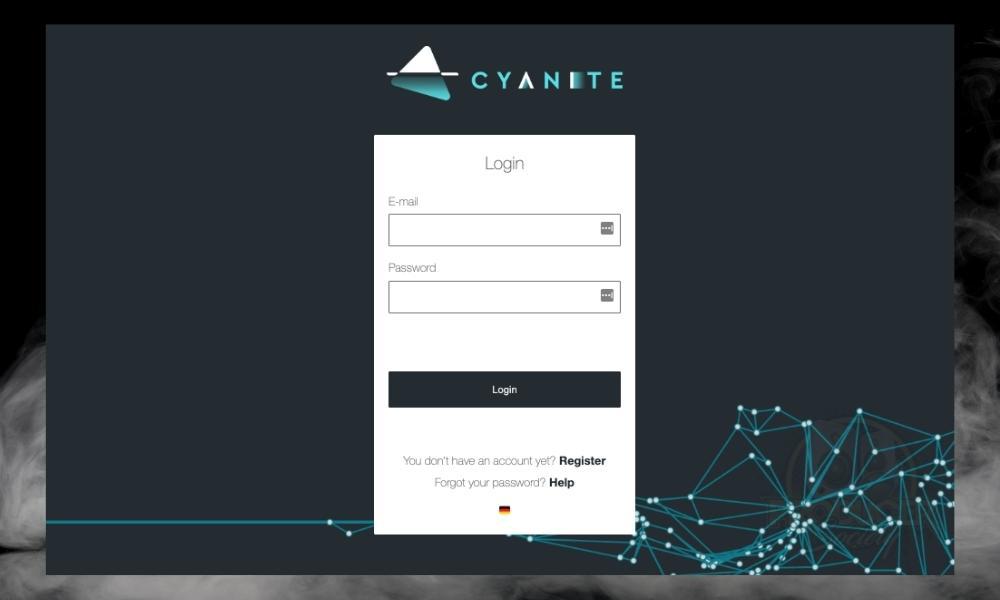
Just make an account and then log in.
2) Drag and Drop the Audio File Into Cyanite

A) Paste A YouTube Video Link Into the “Import” Bar
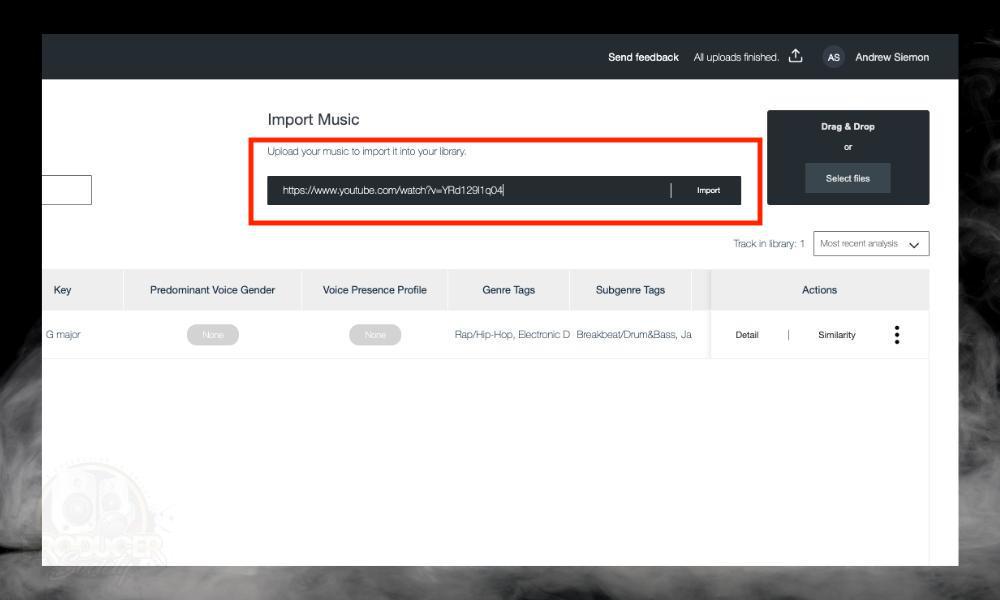
3) Wait For The Results (BPM, Time Signature, Key Signature)

And that’s how you use Cyanite.ai’s tool for finding the key, time signature, and other information. I also did it with my song “Inversions,” and it said the key was E Minor – which it is and I know because I wrote it.
How to Find The Key With Tunebat
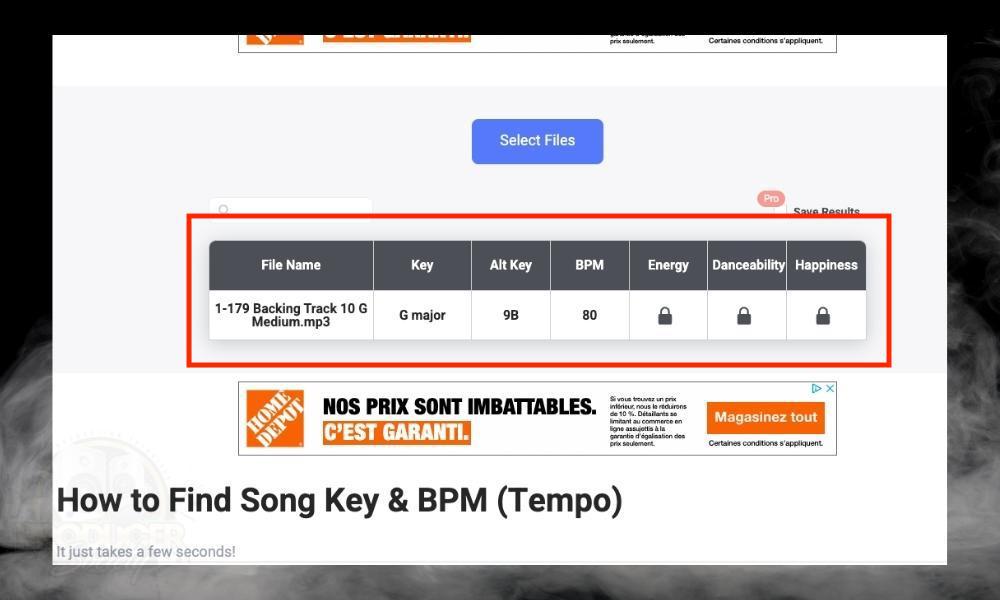
The website Tunebat does the very same thing, although, it might actually be faster and easier to do because you don’t need to make an account. It doesn’t have the ability to analyze YouTube videos, however, and it also won’t find the time signature either.
Either way, all you have to do is drag and drop your audio file right onto the “Select Files” button. Once it has completed analyzing the file, it’ll tell you the key, the BPM, and the Alt Key.
How to Find the Key With Melodyne 5
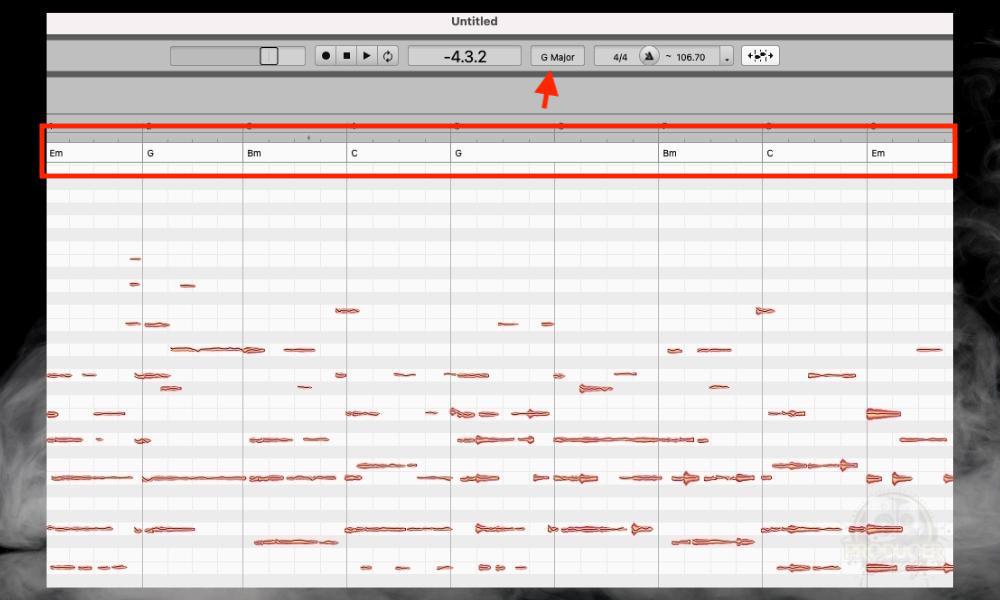
Melodyne 5 (on Plugin Boutique) is a software package that allows the manipulation of audio on a note-by-note basis.
To find the key of your song with Melodyne, all you have to do is open the stand-alone version and then drag your track into it. There is a simple tool included that will analyze the notes used in the recorded song and the key will show up in a box on the top of the screen.
If it’s not working, make sure you try the following things:
1) You’ve opened the stand-alone version and not the plugin version of Melodyne
2) You’ve chosen Polyphonic Algorithm and not Melodic
Melodyne can determine the key from a melody, or you can have it analyze the chords as I’ve highlighted in the image above. It’s super cool what it can do. As I’ve written in my tutorial all about it, it’s a great tool but there’s definitely a learning curve there if you want to get really serious.
Finding the key with it, on the other hand, is as easy as anything. Another thing I’ll say is that it might detect the song as its relative major and not the minor key.
For example, the above example is in the key of E Minor actually, but the relative major is G Major. They have the same notes, but the computer can’t differentiate between happy and sad keys.
How to Find The Key With Antares Auto-Key Plugin
Antares Auto-Key (also on Plugin Boutique) will automatically find the key and scale as well. Antares Auto-Tune is more of a vocal tuning tool than an audio editor like Melodyne, but it’s worth owning both and many people do.
It can find the key in real-time, or you can upload a whole file for it to analyze even faster. A light-up keyboard gives you a visual of the notes detected as well which is pretty cool. Out of all the plugins thus far, Antares Auto-Key is probably the easiest to use for finding the key. Here’s how to use it:
1) Import The Song Into Your DAW
2) Open Auto-Key On The Master Track
3) Press Play
4) Wait for Auto-Key To Tell You The Key
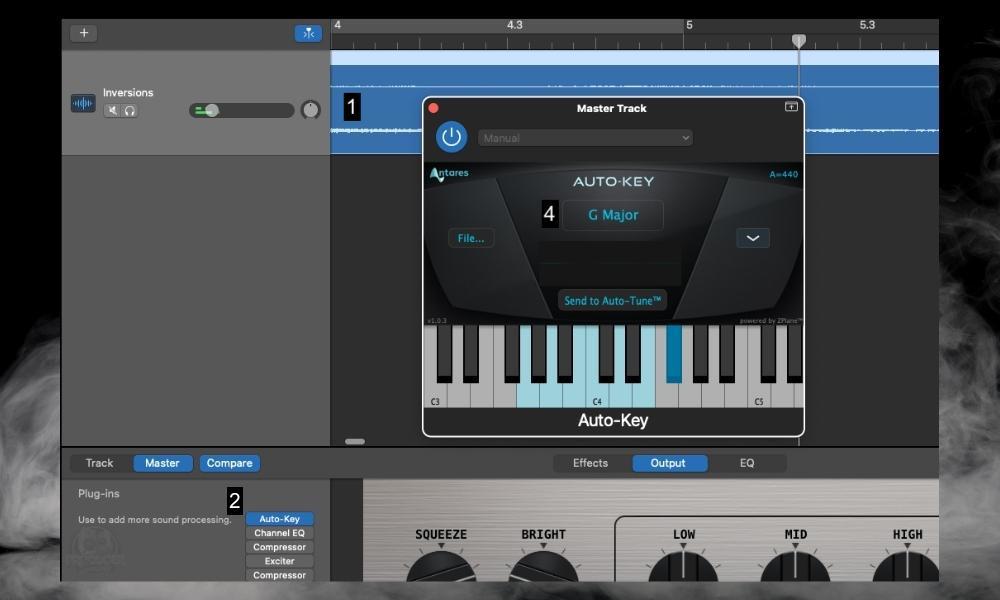
How to Find the Key With Guitar Pro
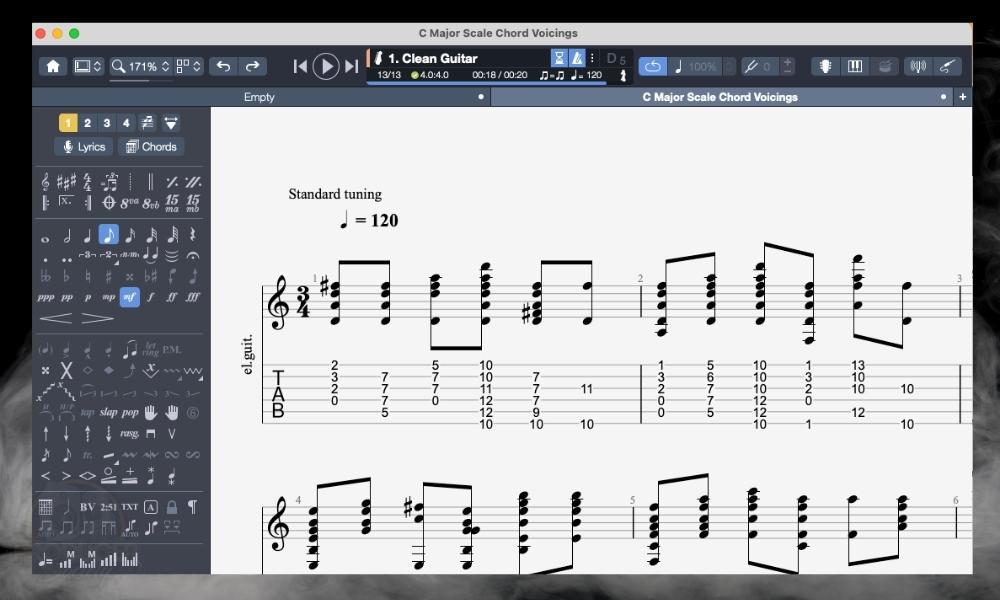
Guitar Pro is software that lets guitar and bass players share their tablatures using a sheet music program. That said, this method is only going to work if you have a tab or some sheet music for the song.
Guitar Pro is still great though, and I’m super glad I got it because I use it all the time. To get Guitar Pro to find the key for you follow these steps:
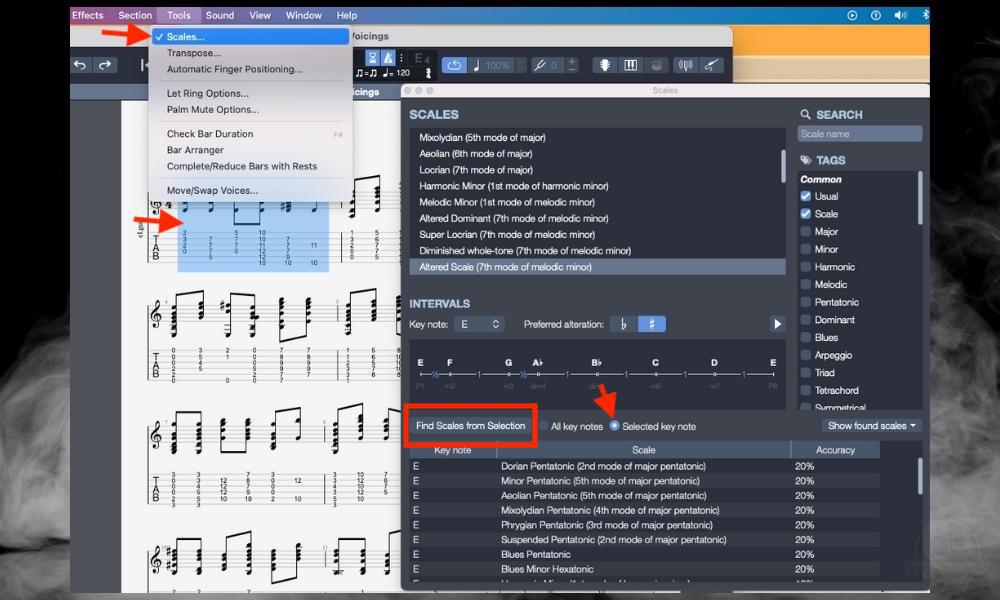
Step 1: Import the Song’s Sheet Music Or Tablature Into Guitar Pro
Step 2: Highlight a Portion of the Song
Step 3: Click on “Tools”
Step 4: Click on “Scales”
Step 5: Click “Find Scales from Selection”
Step 6: Check the Result.
It will give you the major scale of the key signature. So here again, you’ll have to determine whether it is actually the major key, or if it’s the relative minor. There you have it. You’ve got 5 quick and dirty ways to find the key.
You can’t always rely on the technology though, so I’m going to show you how a musician would do it too, including the music-school approved way, in addition to the more practical way that most musicians use in a real-life context.
What Is A Key Signature?
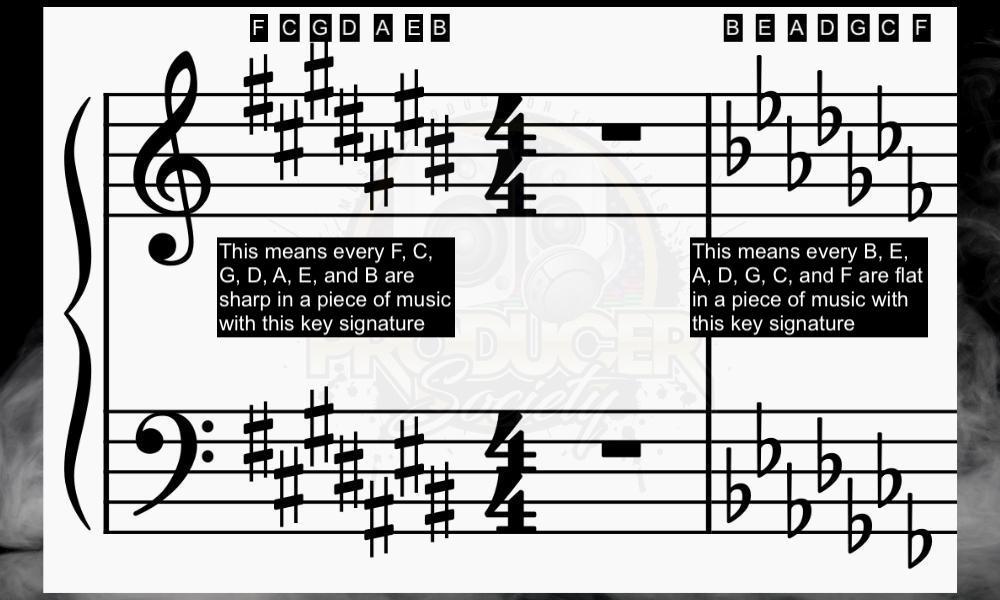
Before we start, it’s worthwhile to explain what a key signature is, that way we can contextualize some of this information a little bit and provide more clarity. A key signature is a shortcut telling you what scale the song is written in.
It’s made of either sharps or flats and it tells you how many there are and which notes they apply to. They appear at the beginning of each line of sheet music, but if you’re playing by ear, they still apply.
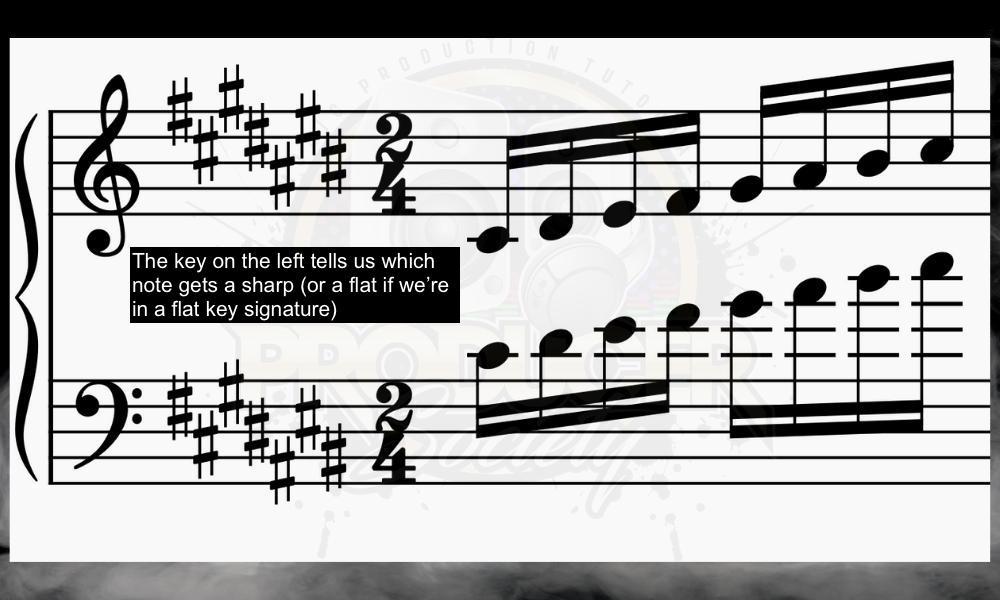
As I said in my article on key signatures, there are 15 key signatures in all of Western Music theory, however, some of them are enharmonic. This means they have the same notes but with different names.
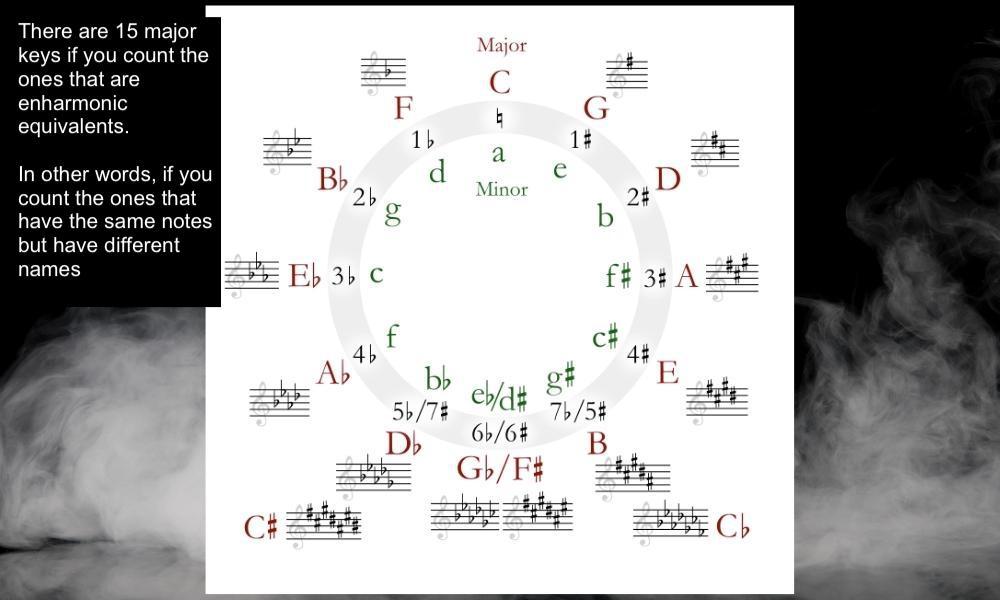
But every one of them has two keys that use that key signature – one major and one minor. When you work out the key signature using sheet music, you need to check if the key is major or minor. This is mostly done by ear – does the song sound minor or major? Does it sound happy or sad?
Why Do You Need To Know The Key Signature Of A Song?
There are plenty of musicians who play without really understanding what key they’re playing in. This doesn’t detract from their playing.
But knowing what key you’re in gives you a basic knowledge of the chords likely to be used in the song – a framework, in simple terms.
But knowing the key tells you a lot more than that. It tells you how high or low the song is in terms of pitch; it tells you the notes of the song; It tells you what chords the song is likely to use; it tells you what type of intervals you’ll find in the song, and it probably tells you other things that a more experienced musician knows about.
Anyway, without further ado, I’m going to show you how to find the key now with the method that all the schools and teachers will tell you about, and then I’ll show you the other way which is a lot more common in a real-life context.
2) How to Determine A Song’s Key Using The Tonic
A) Find the First and Last Note of the Piece
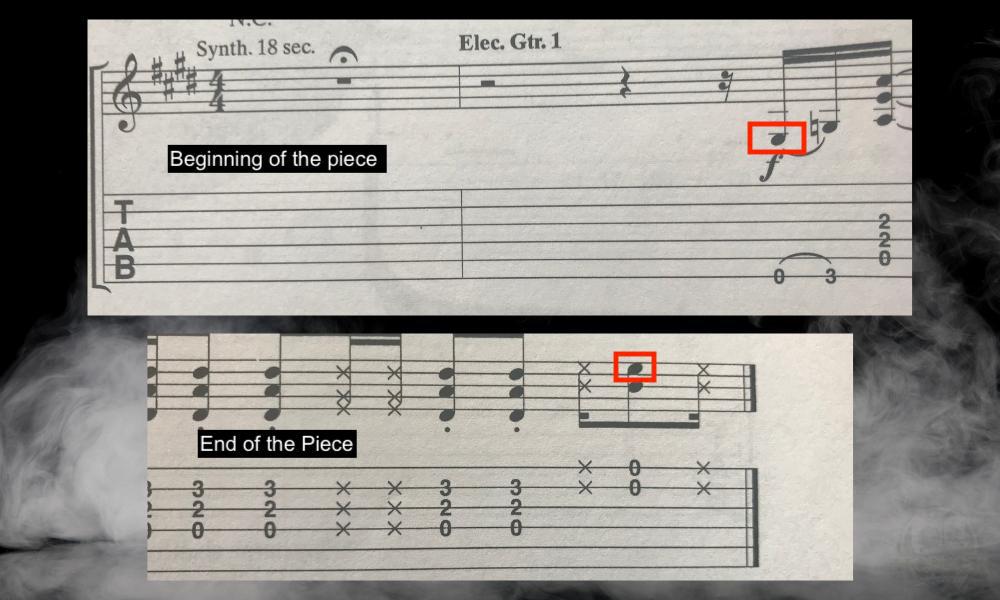
If you play the piano, you can check the sheet music if you have it. Look at the last bass note of the piece first. This is the most likely to be the tonic note. If it matches the first bass note of the piece, then you most likely have your answer.
If you don’t have the sheet music, listen to the piece from a recording. Stop it right after the first note or two. Keeping the first note in mind – it can help to sing it – play a note on the piano or guitar that’s your best guess. If it’s not correct, work out if it’s higher or lower than the note you heard or are singing.
Keep playing notes until you hear a match. Remember that note – or write it down. Then go to the end of the piece and listen to the very last note or chord. Start by playing the note you worked out to be the first note to see if it matches. If so, you have your answer.
If the last note doesn’t match the first, work out if the first note belongs in the chord of the last note. For instance, if your first note was an E and the last note was a C, it could imply the key of C major. But it could also be an A minor.
B) Look at the Order of Sharps and Flats (If You Have Sheet Music)
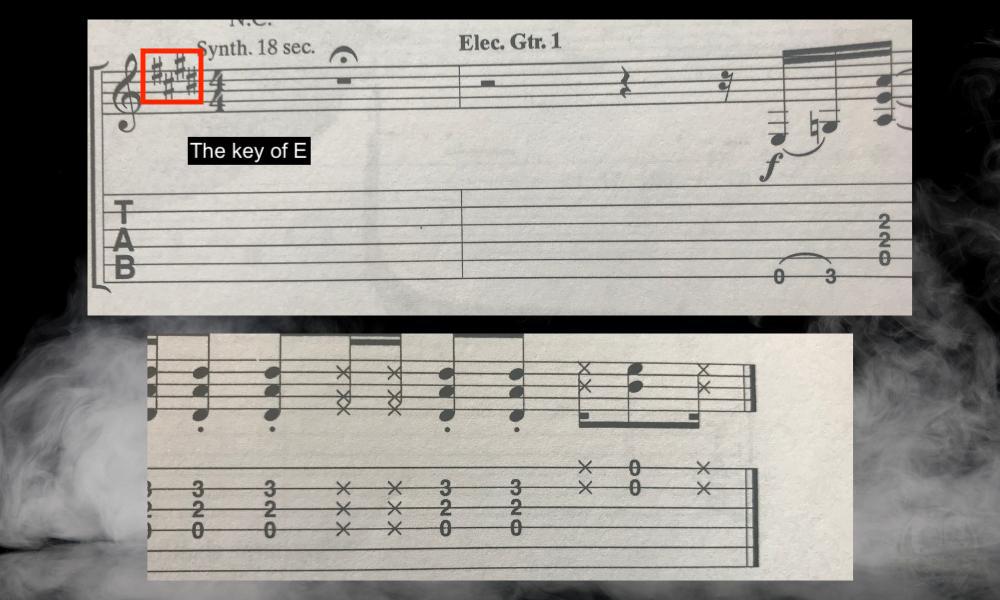
If you have sheet music, you can look at the number of sharps or flats in the key signature. Sharps and flats always appear in the same order.
First of all, it’s good to know the order of the sharps as they increase from 1 to 7. This will help you to know what the sharps are immediately without having to read them or look them up.
3) Determining The Key Signature With Sharps – Step-By-Step
Order of Sharps
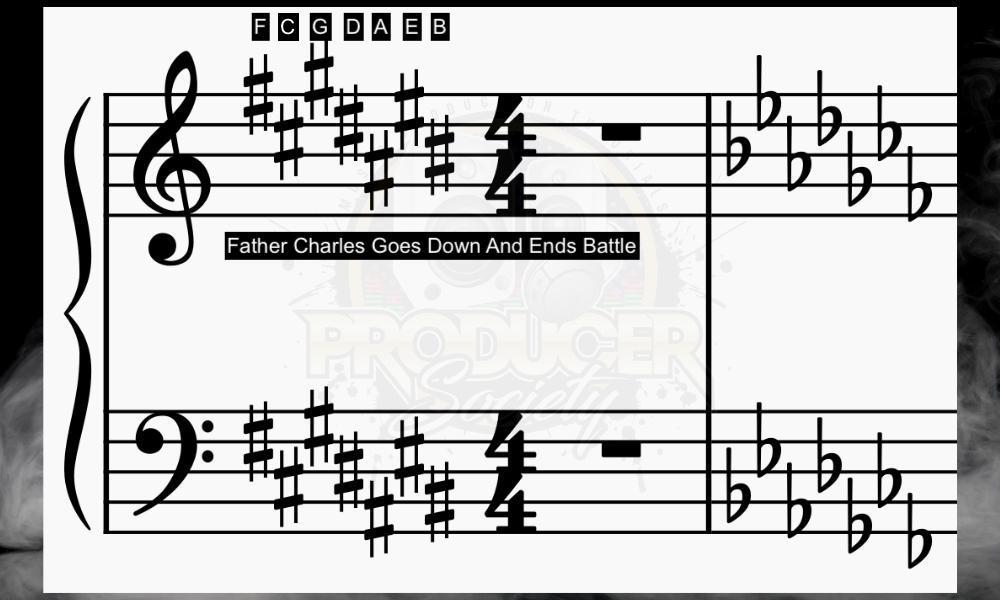
Father Charles Goes Down And Ends Battle. This phrase has been used for decades for music students to remember the order of the sharps and the order they go in at the beginning of each line of music.
For instance, if you’re playing in a key with four sharps, just say to yourself, “Father Charles Goes Down” and you’ll know that the four sharps you’ll be dealing with are F, C, G, and D.
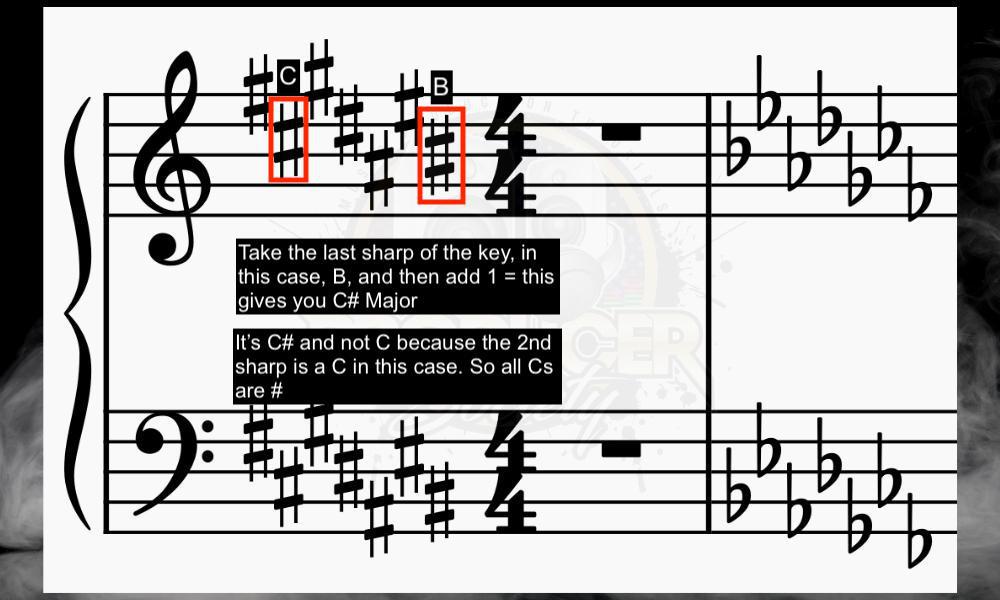
Step 1: Look at the Sharps at the Beginning of the Music
Look at the start of the piece of music, right next to the clef. Sharps look like hashtags.
Step 2: Read the Last Sharp
This works whether you have one sharp or seven. If you have 5 sharps, read the 5th one from the left, etc.
Step 3: Raise That Note by a Half-Step
Whatever note that sharp relates to, raise it by a half-step and that is the name of the major key with that key signature. For example, in the image above, the last sharp is a B#. If we add 1 semi-tone to B#, we get C#. Therefore, the key is C# Major.
Step 4: Confirm That it’s Right With Your Ear
What you can do from there is listen to the song and then play the corresponding major scale over it to make sure it actually goes with it. That said, if you have the sheet music, you probably won’t have to do this.
Look at the last bass note of the piece of music. If it matches, that’s your key. If it’s a minor third lower, it means it’s the relative minor. More about how to figure this out shortly.
4) Determining The Key Signature With Flats – Step By Step
Order of the Flats
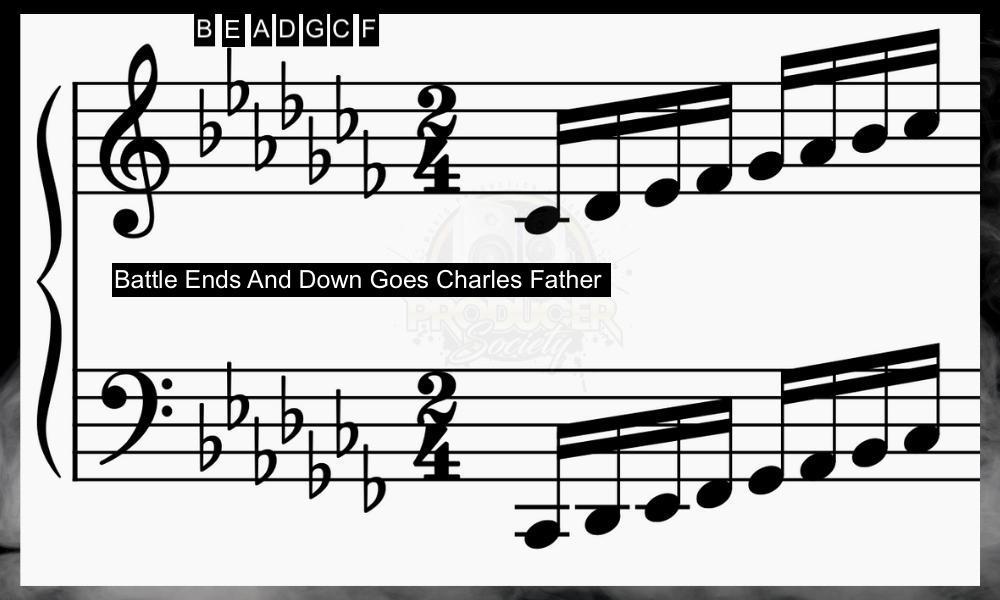
To know the order of the flats, use the same phrase as the order of the sharps, only backward: Battle Ends And Down Goes Charles’s Father. To determine the key signature with flats, follow the steps shown in the next section.
Step 1: Look at the Flats in the Key Signature.
You’ll find the key signature on the left at the start of each line after the clef, just like the sharps. Flats look like lower-case Bs.
Step 2: Read the Second to Last Flat in the Sequence.
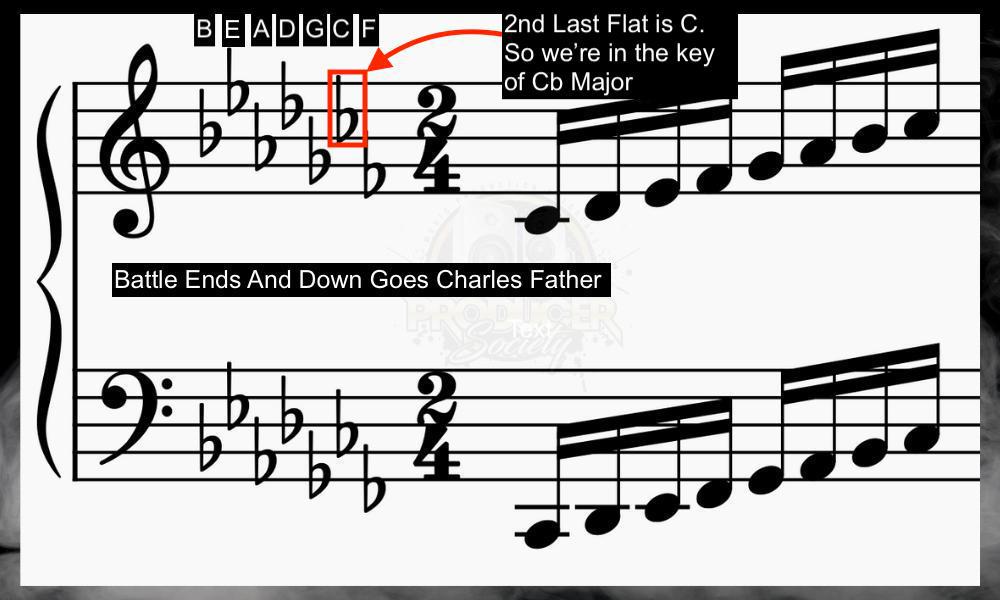
It’s easiest to go to the last flat and step back one flat toward the clef. Note that this doesn’t work if there’s just one flat.
Step 3: That’s the Name of the Major Key.
Now you know the name of the major key with that many flats.
Step 4: Confirm That It’s Right With Your Ear
If your last bass note or chord matches the name of your key, this confirms it. If it doesn’t match, it might be in the relative minor key. More about working that out in a moment.
Note that if you only have one flat in the key signature, you just have to memorize that it’s the key of F major. Once you have two flats or more, you can find the second to last flat and know that’s your major key.
How To Find The Relative Minor Using The Major Tonic
Every key signature has both a major and a minor key. We call these “relative minors”. To work out the relative minor of a major key, all you have to do is count up to 6 from the tonic.
The note you land on at number 6 is the relative minor. I usually think of the tonic as a triad. In a triad, you have the root, 3rd, and 5th. So an Ab Major chord is Ab, C, Eb – the note after E is F. So the relative minor of Ab major is F. Pretty simple to think of it that way, but here’s more of a step-by-step tutorial in case you need it.
Step 1: Find The Tonic of the key
The tonic is the first note of the scale and has the same name as the key. For example, if you’re in the key of Ab major, the tonic is Ab. If you’re in the key of D major, the tonic is D, etc. If you have a piano or another instrument to hand, find the tonic note and play it.
Step 2: Add 6 Notes to the Tonic
Add 6 to the first note of the key. The note you land on is the tonic of the relative minor. So, taking the above example of Ab major, the relative is F minor (Ab, Bb, C, Db, Eb, F). If your major tonic is D, counting to 6 from D will give you the relative minor of D Major, B Minor (D, E, F#, G, A, B, C#).
Step 3: Check The Last Bass Note Or Chord
If your last bass note or chord matches your new minor tonic – this confirms that you’re in the relative minor key.
Check If The Key Is in Harmonic Minor By Looking For The Raised 7th
When we play a harmonic minor scale, we raise the 7th note by a half-step. This raised note is not part of the key signature, so only appears as an accidental. You can use this to help to identify the minor scale in a song.
Let’s say you have a key signature of one flat and you know that this is F major. The relative is D minor and the 7th note in the scale of D is C. To determine if it’s the relative minor, look through the first few measures and see if you find a C sharp. If you do, this means it’s extremely likely the piece is in the relative – D minor.
5) How to Find The Key Using Your Ear
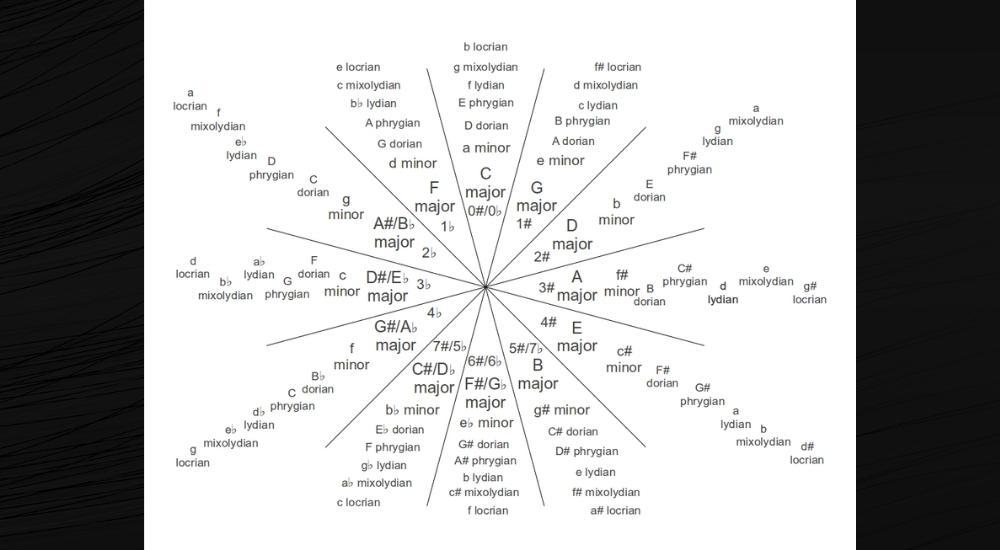
Many musicians, music teachers, and traditional music theory textbooks will tell you that to find a song’s key, you need to look at the first and last note of the piece with the idea that this will be the tonic – or root – of the key. Especially if you’re looking at the last bass note. This is why I showed it to you first.
However, this isn’t always true. Many songs don’t start on the tonic, but on the 3rd, 5th, or any other note in the scale. While the last note in the bass or treble clef is most often the tonic of the key, it’s still not 100% reliable. If you’re using sheet music that’s treble only, you won’t even have a bass note.
As a matter of fact, when I was first starting out with music, I found this advice to be incredibly frustrating and annoying. Every official teacher, textbook, or professional will tell you to look at the beginning of the sheet music, but what if you don’t have the sheet music?
The truth is that most musicians actually just find the predominant note on their instrument and then use the corresponding diatonic scale to find the key.
In other words, you single out the note that stands out the strongest in the song, and then you move up the notes of that scale. This is what the professional musician, Jeff Greenleaf (his website here) also said when my researcher spoke to him and asked how he went about it.
![Jeff Greenleaf - How to Determine Key Signatures [The Actual Way]](https://producersociety.com/wp-content/uploads/2022/05/Jeff-Greenleaf-How-to-Determine-Key-Signatures-The-Actual-Way.jpg)
One famous example is J. S. Bach’s Prelude in C minor (BWV999) which is in the key of C minor (3 flats), but it ends in the key of G major. The key signature doesn’t change, but the final chord is evidence.
If you don’t have or use sheet music, then you’ll be finding out the key of your song by ear. All music is connected to sound – and our ears – first and foremost, so this is a good way to do it.
Think of finding the “key” of a song as the same thing as finding the “scale” it’s written in. In order to find out what the key is, you need to build a scale that fits the sound of the song.
Step 1: Find A Note in the Song
Pick a note from the melody of the song. If you know the first chord, you might pick a note that belongs to that chord. For instance, if the first chord is C major and the first note is E, there’s a good chance you’re going to develop a C major scale.
You don’t necessarily have to know the chord though. The first thing you need to do is simple: just find one single note that clearly matches the song.
Step 2: Move Up One-Half Step or One Full Step To Find the Next Note
Having played your initial note, move up by either a half-step or a whole step and listen to see if it fits in with the sound of the song. If you move 2 whole steps in a row, you’re probably in the right place. The reason is that the order of whole steps and half steps in a diatonic major scale is the following:
Whole Step – Whole Step – Half-Step – Whole Step – Whole Step – Whole Step – Half Step
But if it’s a half-step, you’re probably still playing the scale – you’re just playing the scale from a different note than the tonic.
This is also called a mode, which is the basis for my other article on how to find the key of any song on guitar. I would recommend really learning your mode shapes because they help a lot with finding the key of any song.
Step 3: Repeat Until You Find All The Notes That Sound Good With The Piece
Keep moving up by half-steps or whole steps until you’ve completed an 8-note scale. If you’re following the tonality of the song – i.e. whether it sounds major or minor – you should end up with the correct scale. The final note you land on should sound like “home”.
Step 4: Compare and Contrast the Notes to the Corresponding Mode of the Major Scale
As I said though, you won’t necessarily be starting on the tonic of the key when you first find a note that matches your song. You may be landing on the 3rd or the 5th, or even the 6th or 7th. In this case, knowing the major scale using each note as a starting point is very helpful.
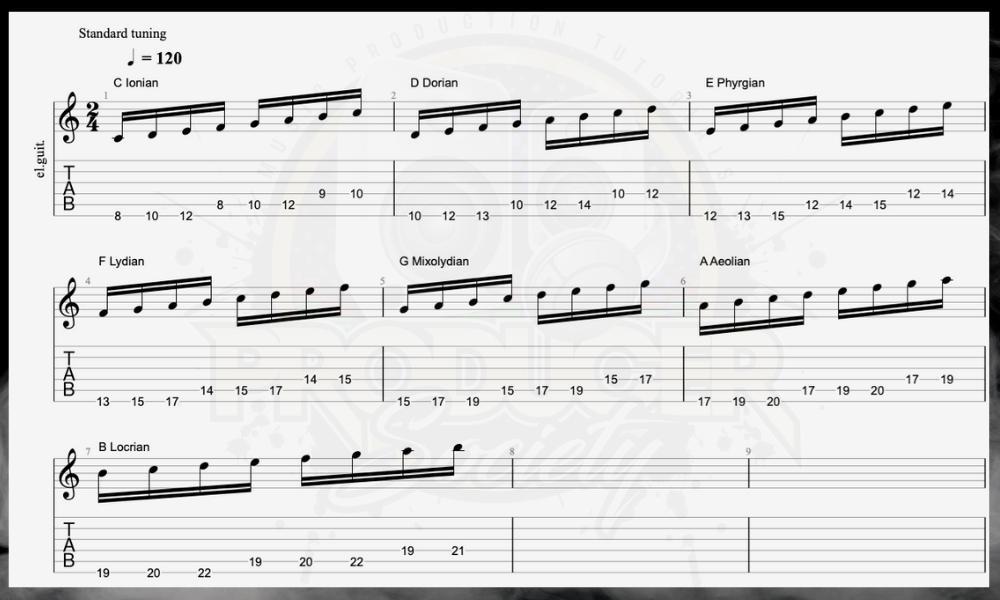
The advantage of learning these positions is that you can play them all over the neck, and use them to figure out whatever key you’re in based on the order of half-steps and whole steps.
For example, if you start on the 19th fret and you move up a half-step and it still sounds like you’re in key, there are only two modes that you could be using from the major scale – Locrian and Phrygian. And if you have them memorized, you just continue up the scale to determine whether it’s one of these scales.
It’s pretty simple. As I pointed out in my guide on learning theory, for this method to be the most effective though, you actually have to know the major scale like the back of your hand. So we’re going to dive into this down below.
How The Major Scale is Constructed
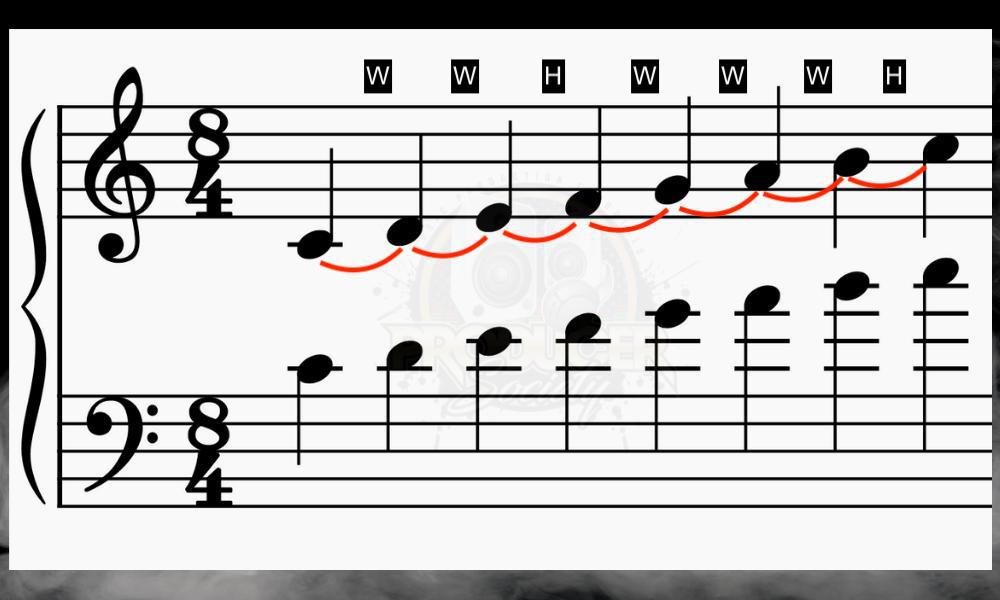
When you’re working out the scale of the song, keep in mind that the major scale is made up of half-steps and whole steps like what I showed you earlier: W W H W W W H.
Look For Scales and Chords Within a Melody
To help find out the key of a song, play a few notes from the melody on your instrument. You’ll often find the notes imply a certain scale or chord. Notes close together will make part of a scale while jumping over a note will imply a chord.
Determining If A Key Is Major Or Minor By Ear
Determining major from minor is very easy. Even if you haven’t been aware of it, you’ve probably been doing it all through your life. Basically, major keys sound “happy” while minor keys sound “sad”. Like most things in life, there are exceptions to the rule, but it’s usually the case.
6) How to Find The Key Using the Chords of the Song
Step 1: Find the Chords for the Song Using Google
This step is pretty self-explanatory. Just Google what the chords are in the song, and you should be able to find them that way. If you find at least a somewhat decent transcription of the song, you should be able to get a pretty good idea of the song’s key.
Step 2: Use the “Circle of Fifths” to Find the Group of Chords That Fits the Song
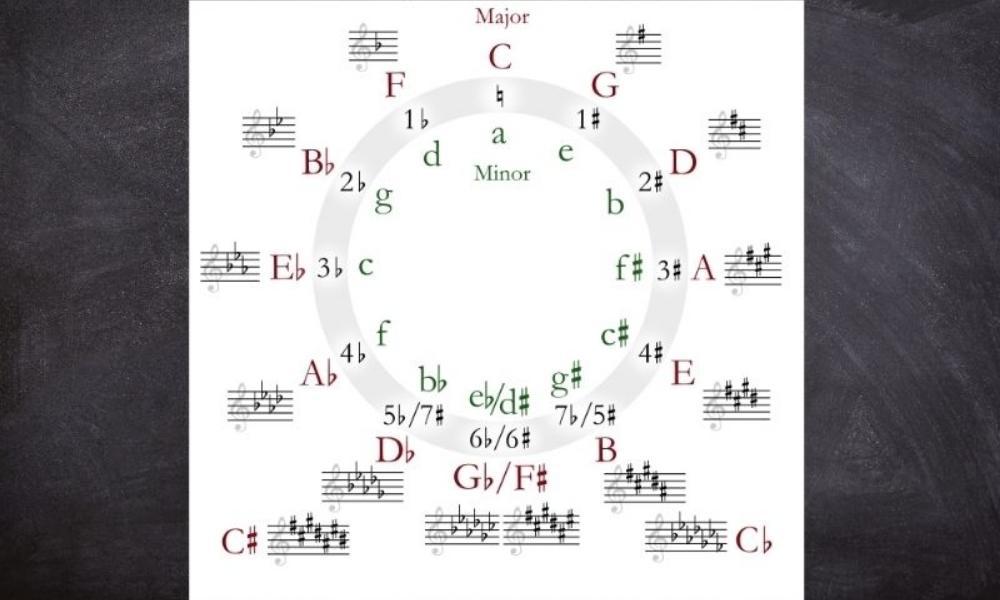
Once you’ve found the main chord or several chords, compare them to the Circle of Fifths to get an idea of the relative major and minor keys. Then, go to Piano Keyboard Guide and find which other chords are in that key.
Step 3: Use Piano-Keyboard-Guide to Find the Chords of that Key
A website I use all of the time for this is Piano Keyboard Guide. Whenever I need the chords to a key, whether major or minor, I just google it and this is usually the site that comes up.
For example, if you have an E minor chord in the song, Google the “chords of E Minor,” and see if the other chords that are in that key fit the song. If not, look at the relative major key, G Major, and compare those chords instead.
Important Things to Note About Finding The Key of a Song
1) Everyone Has Their Own Way Of Doing Things
It’s up to you to decide how you want to figure out the key. I just find a note that’s in key and then move up in half-steps and whole steps to figure out. If you’re not a musician though, something like Auto-Key is an awesome tool and I couldn’t recommend it enough.

 Written By :
Written By :